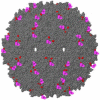Progress and prospects for L2-based human papillomavirus vaccines
- PMID: 26901354
- PMCID: PMC4911254
- DOI: 10.1586/14760584.2016.1157479
Progress and prospects for L2-based human papillomavirus vaccines
Abstract
Human papillomavirus (HPV) is a worldwide public health problem, particularly in resource-limited countries. Fifteen high-risk genital HPV types are sexually transmitted and cause 5% of all cancers worldwide, primarily cervical, anogenital and oropharyngeal carcinomas. Skin HPV types are generally associated with benign disease, but a subset is linked to non-melanoma skin cancer. Licensed HPV vaccines based on virus-like particles (VLPs) derived from L1 major capsid antigen of key high risk HPVs are effective at preventing these infections but do not cover cutaneous types and are not therapeutic. Vaccines targeting L2 minor capsid antigen, some using capsid display, adjuvant and fusions with early HPV antigens or Toll-like receptor agonists, are in development to fill these gaps. Progress and challenges with L2-based vaccines are summarized.
Keywords: L2; adjuvant; anogenital cancer; capsid display; cervical cancer; human papillomavirus; multimer; non-melanoma skin cancer; oropharyngeal cancer; toll-like receptor agonist.
Figures

Similar articles
-
Developments in L2-based human papillomavirus (HPV) vaccines.Virus Res. 2017 Mar 2;231:166-175. doi: 10.1016/j.virusres.2016.11.020. Epub 2016 Nov 23. Virus Res. 2017. PMID: 27889616 Free PMC article. Review.
-
Virus-like Particle-Based L2 Vaccines against HPVs: Where Are We Today?Viruses. 2019 Dec 23;12(1):18. doi: 10.3390/v12010018. Viruses. 2019. PMID: 31877975 Free PMC article. Review.
-
Broad Cross-Protection Is Induced in Preclinical Models by a Human Papillomavirus Vaccine Composed of L1/L2 Chimeric Virus-Like Particles.J Virol. 2016 Jun 24;90(14):6314-25. doi: 10.1128/JVI.00449-16. Print 2016 Jul 15. J Virol. 2016. PMID: 27147749 Free PMC article.
-
Oral immunization with bacteriophage MS2-L2 VLPs protects against oral and genital infection with multiple HPV types associated with head & neck cancers and cervical cancer.Antiviral Res. 2019 Jun;166:56-65. doi: 10.1016/j.antiviral.2019.03.012. Epub 2019 Mar 26. Antiviral Res. 2019. PMID: 30926288 Free PMC article.
-
Chimeric L2-Based Virus-Like Particle (VLP) Vaccines Targeting Cutaneous Human Papillomaviruses (HPV).PLoS One. 2017 Jan 5;12(1):e0169533. doi: 10.1371/journal.pone.0169533. eCollection 2017. PLoS One. 2017. PMID: 28056100 Free PMC article.
Cited by
-
Novel Vaccine Strategies and Factors to Consider in Addressing Health Disparities of HPV Infection and Cervical Cancer Development among Native American Women.Med Sci (Basel). 2022 Sep 13;10(3):52. doi: 10.3390/medsci10030052. Med Sci (Basel). 2022. PMID: 36135837 Free PMC article. Review.
-
Antibody Competition Reveals Surface Location of HPV L2 Minor Capsid Protein Residues 17-36.Viruses. 2017 Nov 10;9(11):336. doi: 10.3390/v9110336. Viruses. 2017. PMID: 29125554 Free PMC article.
-
Novel Production of Bovine Papillomavirus Pseudovirions in Tobacco Plants.Pathogens. 2020 Nov 28;9(12):996. doi: 10.3390/pathogens9120996. Pathogens. 2020. PMID: 33260725 Free PMC article.
-
Improvement of RG1-VLP vaccine performance in BALB/c mice by substitution of alhydrogel with the next generation polyphosphazene adjuvant PCEP.Hum Vaccin Immunother. 2021 Aug 3;17(8):2748-2761. doi: 10.1080/21645515.2021.1875763. Epub 2021 Feb 11. Hum Vaccin Immunother. 2021. PMID: 33573433 Free PMC article.
-
Incorporation of RG1 epitope concatemers into a self-adjuvanting Flagellin-L2 vaccine broaden durable protection against cutaneous challenge with diverse human papillomavirus genotypes.Vaccine. 2017 Sep 5;35(37):4942-4951. doi: 10.1016/j.vaccine.2017.07.086. Epub 2017 Aug 1. Vaccine. 2017. PMID: 28778613 Free PMC article.
References
-
- Munoz N, Bosch FX, de Sanjose S, et al. Epidemiologic classification of human papillomavirus types associated with cervical cancer. N Engl J Med. 2003;348(6):518–27. - PubMed
-
*Defines key hrHPV types that need to be targetted by vaccination
-
- Walboomers JM, Jacobs MV, Manos MM, et al. Human papillomavirus is a necessary cause of invasive cervical cancer worldwide. J Pathol. 1999;189(1):12–19. - PubMed
-
- Munoz N, Bosch FX, Castellsague X, et al. Against which human papillomavirus types shall we vaccinate and screen? The international perspective. Int J Cancer. 2004;111(2):278–85. - PubMed
Publication types
MeSH terms
Substances
Grants and funding
LinkOut - more resources
Full Text Sources
Other Literature Sources
